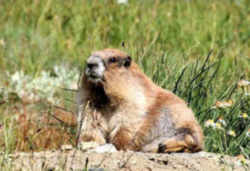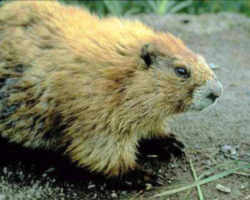Washington State Endemic Mammal
Olympic marmot

(Marmota olympus)
Adopted in 2005.
In 2009, the Olympic marmot, the only endemic mammal in Washington state, was designated as the state endemic mammal following a proposal from the 4th and 5th graders at Wedgwood School in Seattle. The Olympic Marmot inhabits the Olympic Peninsula in the western section of Washington. Olympic Marmots are highly social animals and may live in groups of over a dozen animals. Gregarious bonds are made between animals in a family. Olympic Marmots identify each other by touching noses and smelling cheeks. Olympic Marmots hibernate from September to May. During the morning and afternoon on summer days, they feed and spend their time sunbathing on rocks. In the evening, they return to their burrows. Olympic Marmots are relatively easy to see during the summer months along Hurricane Ridge in the Olympic National Park.Washington Endemic mammal: Olympic marmot

The Olympic marmot (Marmota olympus) is a rodent in the squirrel family Sciuridae. Its close relatives include the hoary marmot and the Vancouver Island marmot. The species occurs only in the U.S. state of Washington, on the middle elevations of the Olympic Peninsula. In 2009, it was declared the state's official endemic mammal.
This marmot is about the size of a domestic cat. It can be identified by a wide head, small eyes and ears, stubby legs, and long, bushy tail. Its sharp, rounded claws aid it in digging burrows. The coat color changes with the season and with age, but an adult marmot's coat is brown all over with small whiter areas for most of the year. This species shows the greatest sexual dimorphism found in marmots, with adult males weighing on average 2.2 kg (4.9 lb) more than females.
Characteristics of the Olympic marmot
Nuzzling, playing, chirping, feeding together; the Olympic marmot is quite possibly one of the most social and gregarious mammals on the peninsula.
They are endemic to the Olympic Peninsula, meaning they are found no where else in the world. The Olympic marmot is a housecat-sized rodent with a
long, bushy tail. Adults can weigh 15 pounds or more before they enter hibernation in September or early October. They are often brownish in color,
but may be yellow or tan colored when they emerge from hibernation in the spring, and almost black in the fall.
Family groups of one adult male, one or more adult females, and several cohorts of young share a home range of 1/2-acre to five acres. In any given
year, about 30 percent of adult females produce litters of 1-6 pups. Pups initially stay close to their burrows when they emerge in late July, but
by mid-August, they can be seen wrestling and chasing each other in enthusiastic play. Marmots have a sharp, piercing whistle that warns others of
intruders or potential predators, and notifies hikers that they are in marmot territory.
Habitat:
Marmots occupy mountain meadows above 4000 feet. Although they are found throughout the Olympic Mountains, they are rare in the wetter southwest
areas of the park. About 90 percent of Olympic marmot habitat is protected within Olympic National Park.
In the 1990s and early 2000s, Olympic marmot numbers declined,
at least partly due to predation by non-native coyotes. Marmots and their habitat are also expected to be sensitive to climate
change. In recent years, marmots have also disappeared from some of the driest meadows in the northeast Olympic Mountains. In response to these concerns,
in 2010 the park initiated a monitoring program that enables volunteers to record the presence or absence of marmots in many meadows throughout the
park.
Diet:
Olympic marmots prefer fresh, tender, flowering plants such as lupine and glacier lilies. In May and June, they will eat roots and may even gnaw on trees. They can double their body weight in the summer and use stored fat during a seven to eight month hibernation.
Washington Law
The law designating the Olympic marmot as the official Washington state endemic mammal is found in the Washington Statutes, Title 1, Chapter 1.20, Section 1.20.038.
Chapter 1.20 RCW
Title 1 GENERAL PROVISIONS
1.20.038
State endemic mammal.
The Olympic marmot, Marmota olympus, is hereby designated as the official endemic mammal of the state of Washington.
[2009 c 464 § 2.]
Notes:
Finding - Intent - 2009 c 464: "The legislature finds that the Olympic marmot, the only endemic mammal in Washington state, should be designated
as the state endemic mammal. The Olympic marmot inhabits the Olympic Peninsula in the western section of the state of Washington. Olympic marmots hibernate
from September to May. During the morning and afternoon on summer days they feed and spend time sunbathing on rocks. In the evening, they return to
their burrow. Olympic marmots are relatively easy to see during the summer months along Hurricane Ridge in the Olympic National Park. Olympic marmots
eat herbs, grasses, and flowers. They prefer plants that are soft and easy to digest. They may also eat fruits, legumes, and insects.
Olympic marmots are highly social and may live in groups of over a dozen animals. Gregarious bonds are made between individuals in a family. Olympic
marmots identify each other by touching noses and smelling cheeks.
The legislature intends to promote awareness of the Olympic marmot by designating the Olympic marmot as the official endemic mammal of the state of
Washington." [2009 c 464 § 1.]
Taxonomic Hierarchy: Olympic Marmot
Kingdom: Animalia
Phylum: Chordata
Class: Mammalia
Order: Rodentia
Family: Sciuridae
Genus: Marmota
Subgenus: Petromarmota
Species: M. olympus








